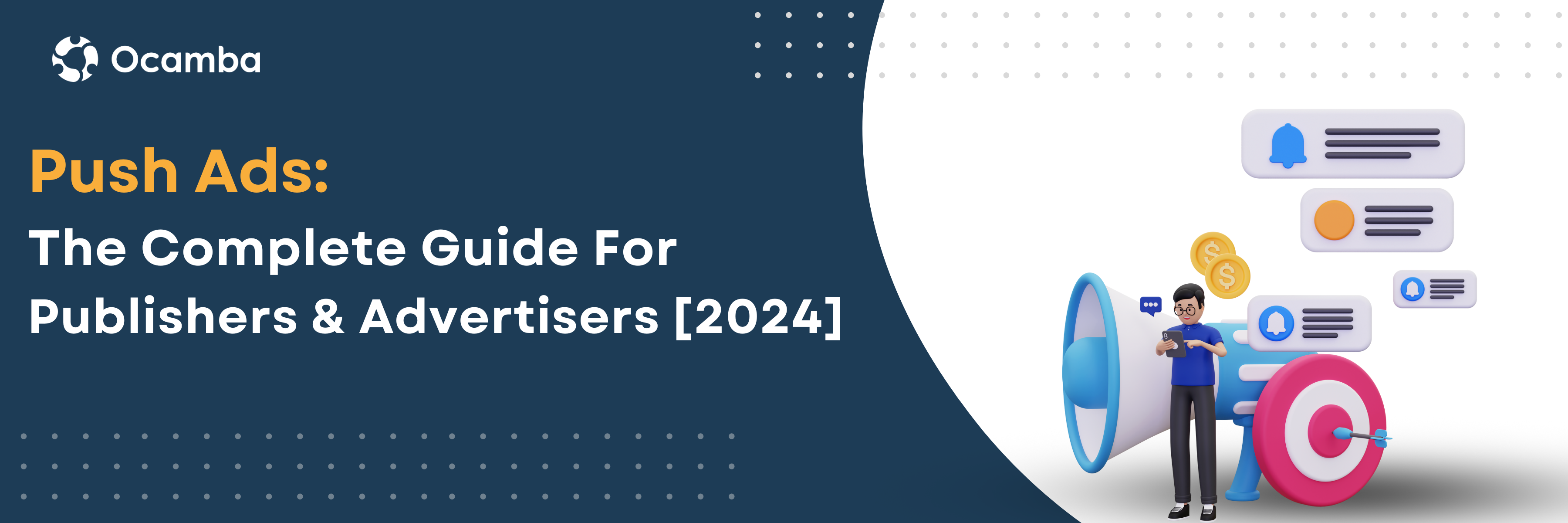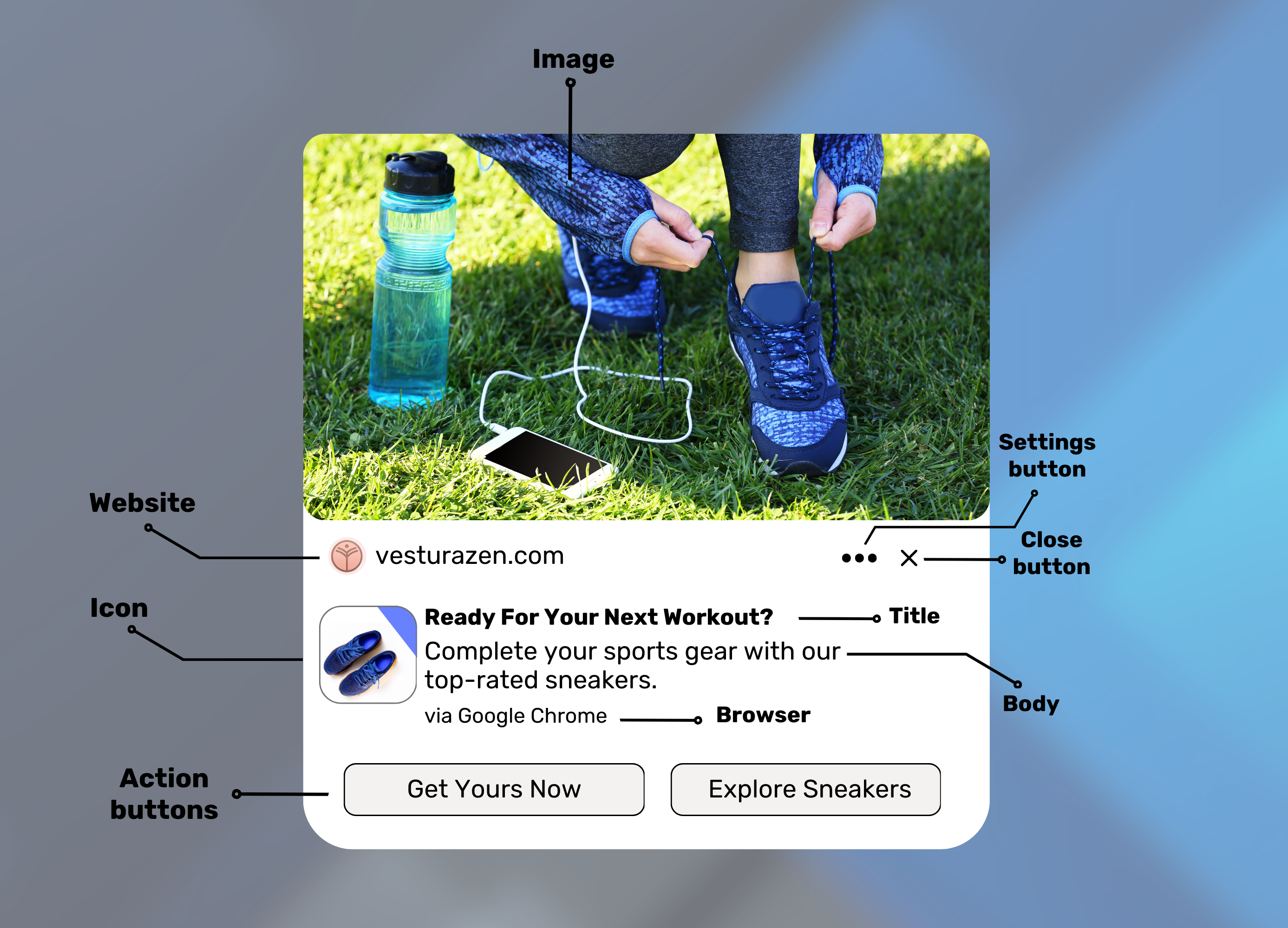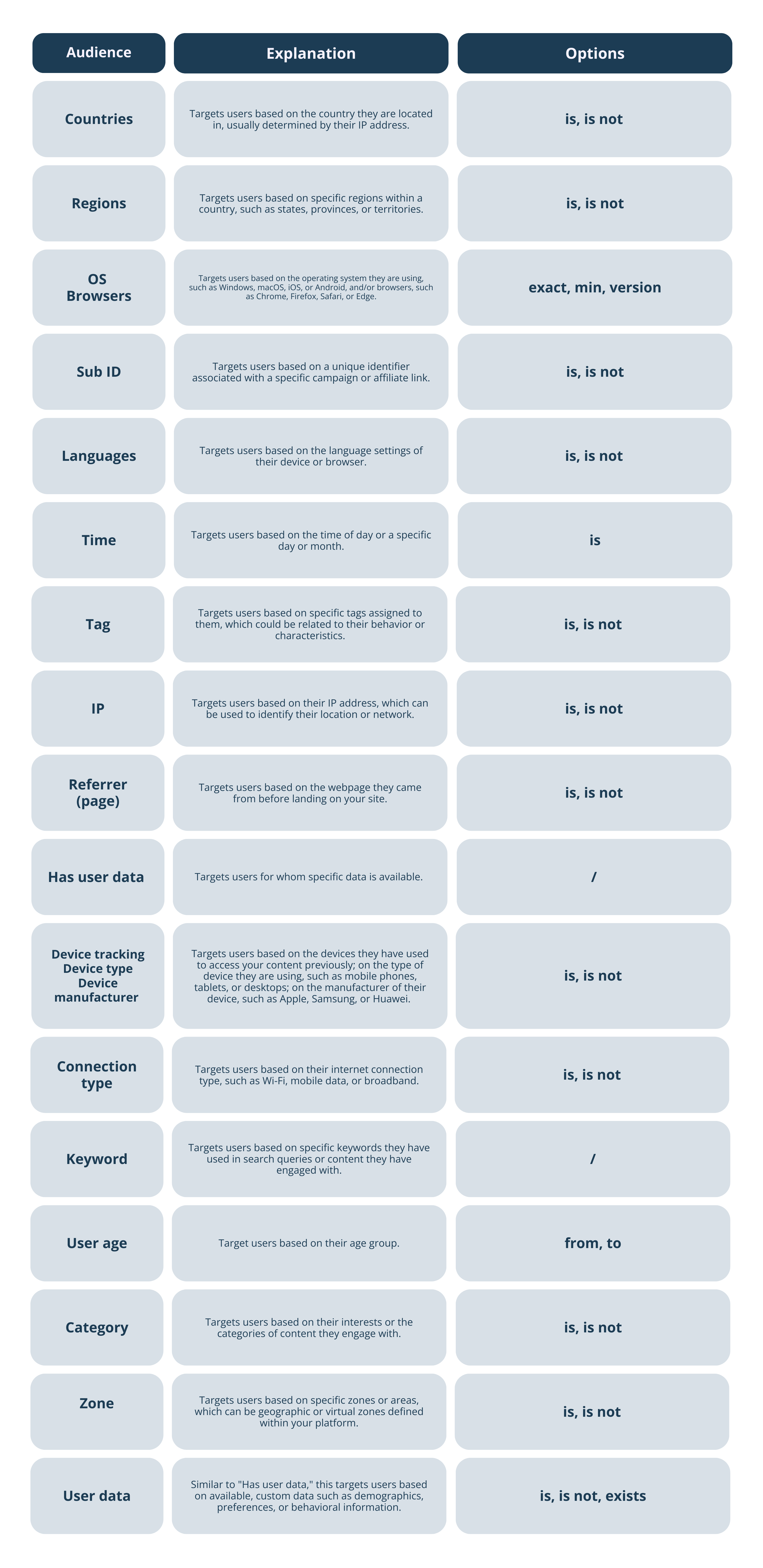Push Ads: Guide For Publishers & Advertisers [2024]

Push Ads are a relatively new format compared to traditional advertising methods, but their effectiveness in both direct and external campaigns has rapidly made them a popular choice among marketers.
This complete guide will walk you through everything you need to know about push ads, whether you’re a publisher looking for external demand, or an advertiser wanting to get quality push traffic.
We will also suggest tools that can help you in your endeavors and provide you with significant advantages over competitors in the industry.
So, let’s dive into it.
What are Push Ads? Push Notifications vs. Push Ads
As you may already know, Push notifications are real-time messages sent directly to users’ devices (phones, tablets, computers, or wearables), facilitating rapid, direct communication between businesses (websites & apps) and users.
Their primary goal is to drive engagement with the website or app associated with the notification.
Usually, businesses use push notifications to send important information, such as:
- updates (new content, features, website & app updates);
- reminders (upcoming events, deadlines, payments);
- alerts (breaking news, weather alerts);
- personalized messages based on user behavior and preferences, and so on.
Push Ads (or Push Advertising), on the other hand, is a form of advertising delivered through push notifications.
These messages are typically sent by advertisers to users’ devices with the goal of promoting products or services to drive user actions, such as clicking on the ad, visiting a website, or making a purchase.
In summary, Push Notifications and Push Ads use the same channel, the push notification delivery system, to send messages to users’ devices. However, they differ in their purposes; Push Notifications’ goal is to deliver messages to drive engagement, while Push Ads’ goal is to deliver advertisements to drive revenue.
Push Ads Design
Just like Push notifications, Push Ads look different across different operating systems on computers - Windows or MacOS, and on mobile devices - iOS and Android, and on different browsers - Chrome, Safari, Firefox, etc.
Here’s an example of a Push Ad on Windows via Google Chrome.

Example of a Push Ad on Windows via Google Chrome
As you may see from the above example, typically, Push Ads are made of several elements, such as:
- Title (Catchy headline)
- Body copy (Usually optional, push notification body copy)
- Icon (Logo)
- Website URL
- Image
- CTAs (Ocamba supports 3 CTAs for Android and 2 CTAs for iOS)
- Settings
- Timestamp
- Browser logo
Notification options: How to Avoid Spamming People with Push Ads?
Ocamba offers some additional features to customize your Push Ads to prevent the perception of spam, and, therefore, improve user experience.

Ocamba’s Hood Engage, the Notification options section
Here’s how these features help avoid the perception of spam in users.
- Type Tag: This option allows you to remove previously delivered notifications with the same tag. It helps prevent users from being overwhelmed by multiple similar notifications, and it keeps notifications relevant and up-to-date.
- Vibration Pattern: Customize the length and pause between two vibration pulses (e.g., 200,100,200 milliseconds) when a notification is displayed. This option is available only for Android users, and it provides a subtle and non-intrusive way to alert users, reducing the likelihood of annoyance.
- Renotify: Replace old notifications with new ones using the silent method. This feature is applicable only with the tag option. It keeps notifications fresh and relevant without disturbing users with repetitive alerts, minimizing the perception of spam.
- Require Interaction: This option demands action from the user and is applicable only for desktop users. It ensures that notifications are meaningful and engage the user directly, avoiding passive or ignored notifications.
- Silent: This option allows you to serve notifications without sound and vibration, applicable only to mobile devices. This way, you can deliver important information discreetly, reducing the chance of annoying users, and preventing notification fatigue.
Types of Push Ads Campaigns: Direct vs. External Push Advertising
There are 2 types of Push Advertising Campaigns:
- Direct Push Advertising
- External Push Advertising.
The main difference between Direct Push Advertising and External Push Advertising is who manages and sends the ads.
In Direct Push Advertising, the publisher directly manages and sends ads to their own subscriber base. On the other hand, External Push Advertising involves third-party advertisers using ad networks to send ads to a broader audience.
With Ocamba, you’ll get a synergy of Ad serving and Push within a single platform, eliminating the need to purchase separate ad technology and push notification/customer engagement tools.
Additionally, both types can utilize real-time bidding (RTB), though they do so in different ways.
Direct Push Advertising
Direct Push Advertising is a form of advertising where the publisher, such as an app or website owner, directly manages and sends ads, using a push notifications delivery system, to their own subscriber base.
In this case, the publisher is, at the same time, the advertiser, who has full control over the content and timing of the Push Ads, and all revenue generated from direct push advertising goes to the publisher.
External Push Advertising
External Push Advertising is a form of advertising where ads are sent through a push notifications delivery system, utilizing ad networks, to a broader audience.
The revenue generated from this type of campaign is typically shared between the publisher and the ad network.
The Role of RTB in Push Advertising
Real-Time Bidding (RTB) is an automated process that allows advertisers to bid for ad space in real-time. This means that, when a user visits a website or an app, an auction takes place in milliseconds, and the highest bidder’s ad is displayed to the user.
This is the way RTB works in general, meaning, when it comes to Push Ads, advertisers bid for these ad placements the way they would bid for any other ad placement.
Although it may seem counterintuitive since there are no other bidders, RTB is still very useful in Direct Push Advertising.
Here’s how.
RTB in Direct Push Advertising
Even though, in Direct Push Advertising (self-advertising), the publisher and the advertiser are the same entity and the publisher typically only runs their own Push Ads, RTB can still play a significant role in increasing the effectiveness of these campaigns.
1. Audience Targeting
RTB allows the publisher to target specific user groups with the most relevant internal Push Ads, increasing the likelihood of engagement and conversion.
For example, if an e-commerce website wants to promote 5 different product categories, among which is electronics, they can use RTB to target specific user groups who have previously purchased or browsed gadgets, smartphones, and other electronic items.
2. Dynamic Ad Serving
RTB can dynamically serve the most appropriate ads based on real-time data. For instance, if a user is on a website browsing and showing interest in a particular product category, the system can prioritize ads related to that category on the spot.
3. A/B testing
Some RTB algorithms, such as Ocamba’s, include A/B testing options that can try out different variations of ads to see which ones perform best. This helps the publisher refine their internal ads and maximize their effectiveness.
7 Advantages of Push Advertising Over Other Formats
As mentioned before, the Push format is relatively new compared to some other traditional advertising formats. However, it became very popular due to its effectiveness in both direct and external advertising campaigns.
Here are the main reasons why.
You don’t need large budgets to work with push ad traffic. Ocamba pricing plans, for example, let you send unlimited push notifications but charge based on other parameters. It also offers a No-commitment, Pay-per-use plan for users just getting started.
Unlike other ad formats, users who receive push willingly agree to it. Namely, to receive any kind of push, users must subscribe first and consent to being sent these types of messages. Consequently, they are more open to the offers placed through push.
Due to their playful looks, Push Ads help avoid banner blindness, which is a form of selective attention where web visitors ignore information presented in banners.
Push Ads are hard to ignore. They appear directly on users’ screens. If the users are offline at the moment of delivery, they will get it as soon as they are back online.
The push format gives a sense of urgency due to its instant visibility, pop-up nature, and action buttons.
Push can be highly personalized by leveraging dynamic user behavior data.
Push ads can be used to promote offers to users in any geographical location. Specifically, Ocamba offers push traffic for any country worldwide.
[For Publishers] How to Get External Demand For Push?
As a publisher, website monetization plays a crucial role in sustaining your online business and investing in its growth.
It allows you to create an additional revenue stream for yourself while still continuing to deliver valuable content and maintain your subscriber base.
Here are a few strategies to make your push ad inventory appealing to advertisers, and ensure that your platform remains competitive and financially viable.
1. Partner with Ad networks
Collaborate with established ad networks that connect publishers with advertisers, such as Ocamba. Here is how partnering with ad networks can help you increase your ad revenue.
A larger pool of advertisers
Ocamba currently counts 400+ partnerships with trusted external demands and could provide you with a larger pool of advertisers from the get-go.
Furthermore, it allows you to leverage both its customer engagement app, Hood Engage, and its ad exchange app, Adex, to create direct and external push advertising campaigns seamlessly within one platform.
This integrated approach makes Ocamba suitable for publishers, advertisers, and those who act as both.
Detailed analytics & targeting options
Ocamba offers dynamic web & mobile user behavior analytics with 100+ measures and dimensions that could make your push inventory more attractive to advertisers looking for precise audience targeting.
Furthermore, Ocamba’s drag-and-drop reports designer is very user-friendly, making it easy to analyze data and draw data-driven conclusions without the need to hire someone to interpret the data for you.

Adex - Drag&Drop Reports Designer
Transparency in performance metrics
Ocamba offers clear and detailed performance metrics such as delivery rates, open rates, click-through rates (CTR), and conversion rates to help advertisers make informed decisions and optimize strategies.
By offering such metrics, Ocamba can make it easier for publishers to showcase transparency to advertisers, drive trust, and foster stronger, more collaborative relationships.
Maintain a high-quality subscriber base
Building and maintaining a high-quality subscriber base is essential for attracting advertisers and the success of Push Ads campaigns.
You can do so by prioritizing relevant content, closely monitoring your audience’s preferences and behavior, and keeping them active and engaged. This, in return, can lead to a higher number of external demands, user engagements with the ads placed on your website, and, consequently, increased ad revenue.
What you could also do is offer competitive pricing models, such as cost-per-click (CPC), cost-per-thousand-impressions (CPM), or cost-per-action (CPA) to accommodate different advertisers budgets and campaign goals.
[For Advertisers] How to Buy Push Traffic?
Building your own subscriber base to show Push Ads can be extremely challenging and time-consuming. A popular and effective solution is to use ad technology.
Benefits of utilizing an Ad network
- Immediate Reach: Ad networks collect opt-in users from various websites, apps, and digital services, creating a large and diverse pool of potential ad recipients. By centralizing this data, ad networks can offer advertisers access to a vast and varied audience far beyond what a single publisher could achieve on their own.
- Targeted Advertising: This extensive reach allows advertisers to show their ads to groups with specific demographics, behaviors, and interests across a wide range of users, maximizing the potential impact and effectiveness of their ad campaigns.
- Cost-Effective: Many networks allow you to start with a small budget, making it affordable for advertisers with limited funds. Ocamba, for example, offers a No-commitment, Pay-per-use plan to make it easier for those just getting started.
Which Targeting Options are Available for Push Ads on Ocamba?
Currently, you can target your audience using various parameters with the ability to include (IS) or exclude specific values (IS NOT) for some.
For example, you can set criteria such as “is from Italy” or “is not from Italy” to include or exclude users from certain countries.

Targeting options for Push Ads on Ocamba
Popular Pricing Models in Push Ads
CPC, CPM, and CPA are the most popular pricing models in the push advertising industry, all of which are supported by Ocamba, as well.
Understanding these models helps you choose the best strategy for your campaign goals and budget.
- Cost-per-click (CPC) is a pricing model where advertisers pay only when a user clicks on their push ad. It is a popular choice for campaigns aimed at driving traffic to a website or landing page.
- Cost-per-thousand-impressions (CPM) is a pricing model where advertisers pay for every thousand impressions their push ad receives. This model is suitable for brand awareness campaigns where the goal is to reach as many users as possible.
- Cost-per-action (CPA) is a pricing model where advertisers pay when a user takes a specific action, such as making a purchase or signing up for a newsletter, after clicking on the push ad. This model is performance-based and is suitable for campaigns focused on conversions.
Summary
Push Ads have revolutionized digital marketing by providing an effective way to reach and engage with audiences directly on their devices.
By understanding Push Ads, their different types and benefits, and leveraging advanced tech tools such as Ocamba, you can optimize your campaigns for better performance and higher ROI whether you are a publisher or an advertiser (or both)!
To learn how Ocamba can elevate your push ad strategy, sign up for our live, personalized demo today.
Our experts will guide you through all the features and potential benefits of Ocamba’s apps, demonstrating how you can streamline your operations and achieve a competitive edge without the need for multiple tools.
Don’t miss out on the opportunity to stay within your budget and stick to your strategies effectively!















 www.ocamba.com
www.ocamba.com